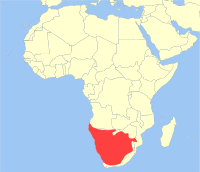Brown hyena
| Brown hyena Temporal range: Pliocene - Recent |
|
|---|---|
 |
|
| Scientific classification | |
| Kingdom: | Animalia |
| Phylum: | Chordata |
| Class: | Mammalia |
| Order: | Carnivora |
| Family: | Hyaenidae |
| Genus: | Hyaena |
| Species: | H. brunnea |
| Binomial name | |
|
Hyaena brunnea Thunberg, 1820 |
|
 |
|
| Geographic range | |
| Synonyms | |
|
Parahyena brunnea |
|
Parahyena brunnea
The brown hyena (Hyaena brunnea, formerly Parahyaena brunnea), also called strandwolf, is a species of hyena found in Namibia, Botswana, western and southern Zimbabwe, southern Mozambique and South Africa. It is currently the rarest species of hyena. The largest remaining brown hyena population is located in the southern Kalahari Desert and coastal areas in Southwest Africa.
The brown hyena inhabits desert areas, semi-desert, and open woodland savannahs. It can survive close to urban areas by scavenging. The brown hyena favors rocky, mountainous areas, as they provide shade and it is not dependent on the ready availability of water sources for frequent drinking. Home ranges are 233 to 466 km2 (90 to 180 sq mi) in size.
Brown hyenas are distinguished from other species by their long shaggy coat and pointed ears, a dark brown coat and a short tail. Their legs are striped brown and white, and adults have a distinct cream-colored fur ruff around their necks. Erectile hairs up to 305 mm (12.0 in) in length cover the neck and back and bristles during agonistic behavior. Body length is 144 cm (57 in) on average with a range of 130–160 cm (51–63 in). Shoulder height is 70–80 cm (28–31 in) and the tail is 25–35 cm (9.8–13.8 in) long. Unlike the larger spotted hyena, there are no sizable differences between the sexes, although males may be slightly larger than females. An average adult male weighs 40.2–43.7 kg (89–96 lb), while an average female weighs 37.7–40.2 kg (83–89 lb). Brown hyenas have powerful jaws. Young animals can crack the leg bones of springboks within five minutes of birth, though this ability deteriorates with age and dental wear. The skulls of brown hyenas are larger than those of the more northern striped hyena, and their dentition is more robust, indicating a less generalized dietary adaptation.
Brown hyenas have a social hierarchy comparable to those of wolves, with an alpha male and alpha female. They live in clans composed of extended families of four to six individuals. Clans defend their territory and all members cooperate in raising cubs. Territories are marked by ‘pasting’, during which the hyena deposits secretions from its large anal gland on vegetation and boulders, which is located below the base of the tail and produces a black and white paste. Brown hyenas maintain a stable clan hierarchy through ritualized aggressive displays and mock fights. Emigration is common in brown hyena clans, particularly among young males, which will join other groups upon reaching adulthood.
...
Wikipedia

